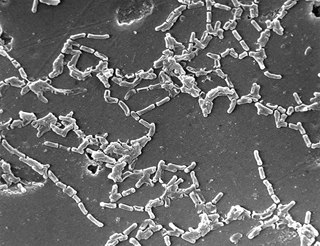Related Research Articles

Mycobacterium tuberculosis is a species of pathogenic bacteria in the family Mycobacteriaceae and the causative agent of tuberculosis. First discovered in 1882 by Robert Koch, M. tuberculosis has an unusual, waxy coating on its cell surface primarily due to the presence of mycolic acid. This coating makes the cells impervious to Gram staining, and as a result, M. tuberculosis can appear either Gram-negative or Gram-positive. Acid-fast stains such as Ziehl-Neelsen, or fluorescent stains such as auramine are used instead to identify M. tuberculosis with a microscope. The physiology of M. tuberculosis is highly aerobic and requires high levels of oxygen. Primarily a pathogen of the mammalian respiratory system, it infects the lungs. The most frequently used diagnostic methods for tuberculosis are the tuberculin skin test, acid-fast stain, culture, and polymerase chain reaction.

Mycobacterium is a genus of Actinobacteria, given its own family, the Mycobacteriaceae. Over 190 species are recognized in this genus. This genus includes pathogens known to cause serious diseases in mammals, including tuberculosis and leprosy in humans. The Greek prefix myco- means "fungus," alluding to the way mycobacteria have been observed to grow in a mold-like fashion on the surface of cultures. It is acid fast and cannot be stained by the Gram stain procedure.
Mycobacterium marinum is a slow growing mycobacterium (SGM) belonging to the genus Mycobacterium and the phylum Actinobacteria. The strain marinum was first identified by Aronson in 1926 and it is observed as a pathogenic mycobacterium. For example, tuberculosis like infections in fish (mycobacteriosis) and skin lesions in humans.
Mycobacterium africanum is a species of Mycobacterium that is most commonly found in West African countries, where it is estimated to cause up to 40% of pulmonary tuberculosis. The symptoms of infection resemble those of M. tuberculosis.
Mycobacterium brisbanense is a member of the Mycobacterium fortuitum third biovariant complex. They are rapidly growing ubiquitous environmental organisms that normally inhabit soil, dust and water. These organisms frequently are human pathogens that cause a wide spectrum of clinically significant disease. It is important for practitioners to be aware of these organisms as possible etiological agents, as they are resistant to most first-line anti-tuberculous agents.

Mycobacterium chelonae is a species of the phylum Actinobacteria, belonging to the genus Mycobacterium. Mycobacterium chelonae is a rapidly growing mycobacterium, that is found all throughout the environment including sewage and tap water. It can occasionally cause opportunistic infections of humans.
Mycobacterium diernhoferi is a species of the phylum Actinobacteria, belonging to the genus Mycobacterium.
Mycobacterium farcinogenes is a species of the phylum Actinobacteria, belonging to the genus Mycobacterium.
Mycobacterium goodii is an acid-fast bacterial species in the phylum Actinobacteria and the genus Mycobacterium.
Mycobacterium gordonae is a species of Mycobacterium named for Ruth E. Gordon. It is a species of the phylum actinobacteria, belonging to the genus Mycobacterium.
Mycobacterium avium complex is a group of mycobacteria comprising Mycobacterium intracellulare and Mycobacterium avium that are commonly grouped because they infect humans together; this group, in turn, is part of the group of nontuberculous mycobacteria. These bacteria cause disease in humans called Mycobacterium avium-intracellulare infection or Mycobacterium avium complex infection. These bacteria are common and are found in fresh and salt water, in household dust and in soil. MAC bacteria usually cause infection in those who are immunocompromised or those with severe lung disease.
Mycobacterium madagascariense
Etymology: madagascariense, relating to Madagascar where it was first isolated.
Mycobacterium wolinskyi is a rapidly growing mycobacterium most commonly seen in post-traumatic wound infections, especially those following open fractures and with associated osteomyelitis. Mycobacterium wolinskyi is clearly clinically significant, and occurs in the same settings as Mycobacterium smegmatis and members of the Mycobacterium fortuitum complex; they differ from members of the Mycobacterium fortuitum complex in the type of chronic lung disease they produce, with essentially all cases occurring in the setting of chronic lipoid pneumonia, either secondary to chronic oil ingestion or chronic aspiration. Etymology: Wolinsky, named after Emanuel Wolinsky in honour of, and in recognition for, significant contributions to the study of the non-tuberculous mycobacteria.
Rapid growing mycobacterium consists of organism of the Mycobacterium fortuitum group and Mycobacterium chelonae/Mycobacterium abscessus group and these usually cause subcutaneous abscesses or cellulitis following trauma in immunocompetent patients.
Mycobacterium obuense is a species of soil-dwelling scotochromogenic Mycobacterium. The cell wall of M. obuense contains 1-tetradecanol, 2-octadecanol, and 2-eicosanol, and triacylated lipoproteins.
Mycobacterium senegalense is a species of Mycobacterium.
Mycobacterium peregrinum is a species of Mycobacterium.
Mycobacterium novocastrense is a species of Mycobacterium.
Mycobacterium rhodesiae is a species of Mycobacterium.
Mycobacterium seoulense is a species of Mycobacterium.